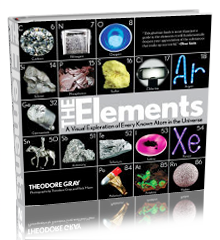Pressurized ampule. | |||
| Sample Image | Spin Video | QuickTimeVR Rotation | |||
| Pressurized ampule. This is a small (1/8" inside diameter) vial of liquid chlorine. Unlike the medicinal ampule listed above, it's actually pure chlorine, made liquid by high pressure (about 7.6 atmospheres or 110 psi). It's safe because (a) it's very small, (b) the quartz ampule is very strong and (c) the ampule is inside a 3/4" diameter solid cast acrylic cylinder (which is intentionally made invisible in the photograph by clever lighting). Ivan, who made this sample, tested it by heating it in a hot bath until the chlorine inside reached the critical point, where the distinction between liquid and gas phases disappears. For chlorine this point is reached at 76.0 atmospheres (1117 psi) and 144C (291F). A note on photography: As a colored liquid, chlorine does not reflect or diffract any light: In order to see the yellow color, you have to have a light background (i.e. you can't light it from the side or front as I do most samples). But I always try to have a black background if possible, so to take these pictures (and the rotation video) I cut a small piece of white paper to the shape of the ampule only slightly larger, and held it behind the sample on the end of a wire sticking out the back. The paper was illuminated by a fiber optic light shining on it, with baffles in place to avoid having any light reach the sample other than by reflection off the paper. You can see some imperfections where the surface of the acrylic cylinder are visible, but all in all it worked pretty well to capture the sense of an ampule floating in space. (What's particularly tricky about this back lighting situation is that every part of the sample is a lens. The acrylic cylinder messes with the focus, the inner quartz ampule messes with the focus, and the fact that the ampule is not perfectly centered results in the apparent position of the white back light shifting back and forth as the sample rotates. It took hours.) Source: Ivan Timokhin Contributor: Theodore Gray Acquired: 7 July, 2006 Text Updated: 29 January, 2009 Price: $80 Size: 1" Purity: 99% | |||
|

